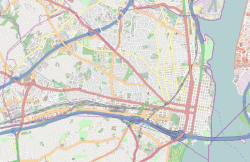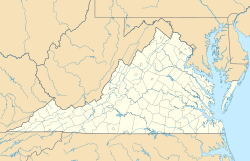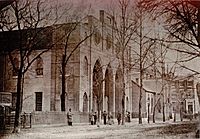Virginia Theological Seminary facts for kids
 |
|
| Type | Private seminary |
|---|---|
| Established | 1823 |
| Affiliation | Episcopal Church |
| President | Ian Markham |
| Dean | Ian Markham |
|
Academic staff
|
21 full-time faculty and numerous adjunct professors |
| Students | 168 |
| Location |
,
38°49′12″N 77°05′32″W / 38.82000°N 77.09222°W |
| Campus | Suburban |
|
Virginia Theological Seminary
|
|
| NRHP reference No. | 80004166 |
| Designated NHL | May 16, 1978 |
The Virginia Theological Seminary (VTS) is a special school in Alexandria, Virginia. It is also known as the Protestant Episcopal Theological Seminary in Virginia. This school trains leaders for the Episcopal Church. It is the biggest and second-oldest school of its kind in the United States.
VTS was started in 1823. It sits on a large campus of about 80 acres in Alexandria. It is right next to Episcopal High School. Many people who studied at VTS have become important leaders. They have served in the American Episcopal Church and other Christian groups. Some have even served overseas.
VTS is part of the Washington Theological Consortium. Since 1938, it has been approved by the Association of Theological Schools in the United States and Canada (ATS).
History of VTS
How VTS Started
VTS began in 1823 because a small group of people wanted to train new church leaders. This was after the Revolutionary War. William Holland Wilmer led this group. Francis Scott Key, who wrote "The Star-Spangled Banner," was also a key member.
In 1818, a church in Alexandria, St. Paul's Episcopal Church, formed a group to help young men study for the ministry. In 1821, the Episcopal Church in Virginia agreed to support a regional seminary. At first, they thought about putting it in Williamsburg. But then, they chose Alexandria. This happened after Congressman Hugh Nelson helped get a lot of money. Wilmer also offered space at St. Paul's Church.
The seminary officially opened in 1823. It had two teachers and 14 students. The first professor was Revd. Reuel Keith. Wilmer also taught theology and church history. VTS was known for its focus on preaching and simpler worship styles. Students also started missionary projects.
Campus Growth and the Civil War
In 1827, land was given to build a proper campus. The seminary moved to a hilltop site outside Alexandria. The first library building was finished in 1855. St. George's Hall was completed in 1856. Aspinwall Hall, a beautiful building, was finished in 1859. These older buildings are now listed in the National Register of Historic Places.
During the American Civil War, from 1862 to 1865, the Union Army used the seminary buildings. They turned them into a military hospital. After the war, the seminary reopened with two professors and 11 students. The campus had been used to care for 1,700 wounded soldiers. About 500 soldiers were buried there.
Becoming More Inclusive
In 1951, John T. Walker became the first African-American student at VTS. He later became a bishop. In 1953, Virginia Seminary joined with the Bishop Payne Divinity School. This was a school for African-American students that VTS had started in 1878.
Helping Descendants of Enslaved People
In 2019, the seminary announced a special fund. This fund was created to help the descendants of enslaved people who worked on the campus. It also helps Black students and Black church members who faced unfair treatment.
In 2021, the fund started giving payments to these descendants. As of May 2021, 15 people had received payments.
What VTS Teaches
The main goal of VTS is to train men and women for leadership in the church. This includes both church leaders and regular members. The seminary focuses on prayer, worship, and community. It also teaches about preaching, teaching, helping others, and working for fairness in society.
VTS wants to prepare its students to serve Jesus Christ. They learn to help people find their purpose and ministry in the world. VTS also offers ongoing education for church leaders and members from many Christian groups. The seminary believes that studying for church leadership usually means full-time study. It also means being a full part of the school's community and worship. They also think that learning is better when it includes different cultures and countries.
Past Leaders of VTS
- William Sparrow: 1868–1874
- Joseph Packard: 1874–1896
- Cornelius Walker: 1896–1898
- Angus M. Crawford: 1898–1916
- Berryman Green: 1916–1931
- Wallace E. Rollins: 1931–1940
- Alexander C. Zabriskie: 1940–1950
- Arthur Stanley Brown-Serman: 1950–1952
- E. Felix Kloman: 1952–1956
- Jesse M. Trotter: 1956–1969
- G. Cecil Woods: 1969–1982
- Richard Reid: 1982–1994
- Martha J. Horne: 1994–2007
- Ian S. Markham: 2007–present
What Students Learn at VTS
Study Programs
VTS offers several study programs:
- The Master in Divinity (M.Div.) program is a three-year program. It is for those becoming church leaders. Students learn about the Bible, church history, worship, and how faith connects to society.
- The Master of Arts (MA) program lets students focus on different areas. These include theological studies, Christian formation, religion and culture, or understanding the Bible.
- The Anglican Studies program is for students who already have a theology degree. It helps them prepare for leadership in the Episcopal Church.
- Doctor of Ministry (D.Min.) in Ministry Development.
- Doctor of Ministry in Educational Leadership.
- The seminary also offers studies that do not lead to a degree.
Teachers at VTS
Ian Markham is the current Dean and President of Virginia Theological Seminary. He has held this role since 2007.
Student Life at VTS
As of July 2012, there were 227 students.
- The average age for M.Div. students was 34. About a third of them were in their 20s.
- Almost half of the students were married.
- The student body was almost evenly split between men and women.
- There were 8 international students.
- The seminary had 22 full-time teachers and 29 part-time teachers.
- There were 50 field education associates and 56 staff members.
Campus Buildings
The VTS campus is located at 3737 Seminary Road.
The Chapel at VTS
The first chapel at the seminary was badly damaged during the Civil War. A new chapel, Immanuel Chapel, was built in 1881. It was a large, beautiful building. On October 22, 2010, a fire destroyed this historic building. Luckily, no other parts of the seminary were damaged, and no one was hurt. Some stained glass windows were lost. The famous words, "Go Ye Into All The World And Preach The Gospel," were also destroyed. However, the pulpit, lectern, and baptismal font were saved. The fire was an accident.
After the fire, the old chapel's foundations were kept. They now form an open-air chapel garden. A new Immanuel Chapel was built nearby. It was dedicated on October 13, 2015. The new chapel includes items saved from the 2010 fire. It also has eight bells and a large organ.
The Library at VTS
The Bishop Payne Library is the seminary's library. It is named after the Bishop Payne Divinity School. The library has over 225,000 books and magazines. It also has 190,000 e-books. The library has special collections on the Bible, church history, and church music.
The Bishop Payne Library also has the African American Episcopal Historical Collection (AAEHC). This collection shares the history of African-American Episcopalians in the United States.
Important Alumni
Many VTS graduates have become important leaders in the Episcopal Church in the United States. Many have also helped with missions around the world. Some notable alumni include:
- William Boone (1811–1864): A missionary bishop in Shanghai.
- John Payne (1815–1874): A missionary bishop in Liberia.
- Channing Moore Williams (1829–1910): A missionary bishop in China and Japan. He helped start the Anglican Church in Japan and Rikkyo University.
- George Herbert Kinsolving (1849–1928): The second bishop of the Episcopal Diocese of Texas.
- Lindel Tsen (1885–1954): The first and only Chinese Presiding Bishop of the Chung Hua Sheng Kung Hui.
See also







